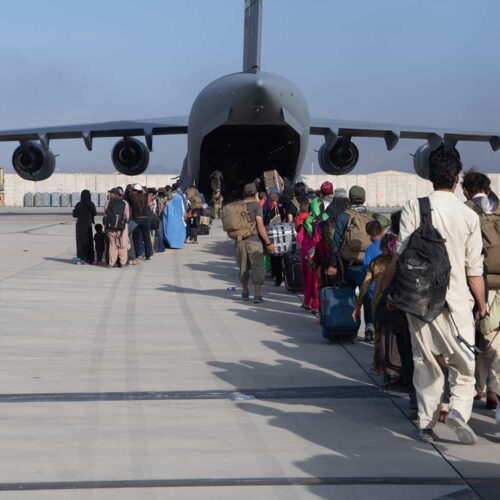Introduction
The last United States military planes flew out of Afghanistan at almost the stroke of midnight Monday, capping the bloody and turbulent end of America’s longest war in history.
In the war’s final weeks, President Joe Biden faced a torrent of criticism for failing to anticipate the sudden collapse of Afghan security forces in the face of advancing Taliban militants.
Critics say this miscalculation led to the last-minute scramble to evacuate Americans and Afghan allies out of Kabul — and left thousands of at-risk Afghans still stranded in a country once again ruled by the Talibans.
But refugee advocates say chaotic withdrawal was years in the making, a result of squandering a 20-year window to resettle Afghan refugees — particularly those who aided the U.S. war effort.
Since its invasion in 2001, the U.S. has resettled about 20,850 Afghan refugees, according to the U.S State Department’s Bureau of Population, Refugees and Migration. That’s a comparatively small number: More than 147,600 Iraqi refugees were resettled during the same period.
And the number of Afghan refugees has dropped significantly in recent years. At the end of July, the U.S. had only resettled 494 Afghan refugees in fiscal year 2021, which ends on Sept. 30. By comparison, more than 2,700 Afghan refugees were resettled in fiscal year 2016, during former President Barack Obama’s final full year in office.
An additional 72,500 Afghans have been resettled through the special immigrant visa program, known as SIV, which was created by Congress in 2009 for Afghans and Iraqis who worked directly with U.S. and allied military forces or embassies.
But that’s still a far cry from the estimated 250,000 Afghan allies who were not evacuated before the pullout.
With better resettlement efforts earlier, advocates say tens — if not hundreds — of thousands of Afghans could have been out of harm’s way, and there might not have been any need for mass evacuations.
“For us, one of the most challenging things in watching the events unfold was knowing just how avoidable all of this was,” said Betsy Fisher, director of strategy at the International Refugee Assistance Project.
Bureaucratic red tape
For years, advocates have criticized the red tape surrounding the U.S. resettlement program, saying the application process is too onerous and backlogged.
Earlier this year, for instance, the processing time for Afghans applying for SIVs reached an average of nearly two years, even though applications are, by law, supposed to be completed within nine months.
The situation worsened under former President Donald Trump, who made anti-immigration measures a hallmark of his presidency. He suspended the resettlement program for 120 days in 2017 and then left it chronically understaffed, significantly slowing down the process for thousands of applicants. He also gradually lowered the annual refugee admissions cap from 85,000 in 2016 to 15,000 in 2020.
“Under Trump, we had an administration committed to not only reducing the number of refugees that could enter [the U.S.], but then also hollowing out the refugee resettlement system itself — to severely weaken it,” said Ali Noorani, president and CEO of the National Immigration Forum. “Now, Afghans who helped our military are facing the very consequences of that.”
Yael Schacher, senior U.S. advocate at Refugees International, said politics prevented Congress from stepping in.
“It would have been great if Congress passed pro-refugee, pro-immigrant legislation, so we could get more visas for Afghan refugees,” Schacher said. “But no Republican was going to put their neck out for a piece of legislation that would expand legal immigration.”
Earlier this year, Biden came under heavy criticism when he broke his campaign promise and kept the annual refugee admissions cap set by Trump. He quickly backtracked, pledging to resettle 62,500 refugees this fiscal year.
But the Biden administration appears likely to fall well short of the goal: At the end of July, the U.S. had managed to resettle 6,274 refugees, with only two months left in the fiscal year.
With Afghans, the Biden administration has instead been turning to an emergency measure, telling refugee resettlement agencies to prepare to receive as many as 50,000 refugees arriving on “humanitarian parole.”
The move will allow Afghans to enter the U.S. without visas and give them a year to complete their application for refugee status or SIVs. In early August, the State Department also authorized giving priority consideration to Afghan refugee applicants who worked for U.S.-based employers but do not qualify for SIVs.
The Biden administration’s moves have been denounced by a handful of vocal Republicans, but polls show a vast majority of Americans — 90% of Democrats and 76% of Republicans — support resettling Afghans.
Noorani said the Biden administration should seize the moment to not only provide immediate relief to Afghans, but also push for an overhaul of the U.S. immigration system.
“I’ve been working on immigration longer than I’d like to admit, and I’ve never seen this kind of bipartisan support for Afghan allies to be resettled here,” Noorani said. “This is an incredible opportunity for the administration — and more importantly, in many ways, for civic society — to actually find a consensus around the immigration issue.”
Rui Kaneya is a senior reporter at the Center for Public Integrity. He can be reached at rkaneya@publicintegrity.org. Follow him on Twitter at @ruikaneya.
Read more in Inside Public Integrity
Watchdog newsletter
Biden’s racial equity efforts for farmers of color hit legal roadblocks
Lawsuits claiming reverse discrimination are holding up efforts to cancel loan debts farmers of color owe.
Cheated at Work
What happened when I reported that USPS keeps cheating mail carriers
The Postal Service has repeatedly been shorting workers on pay.




Join the conversation
Show Comments